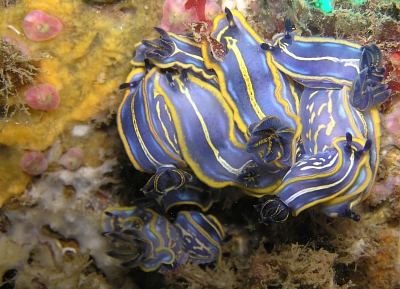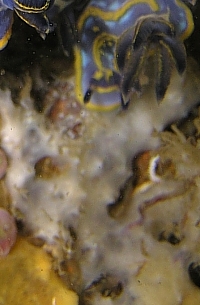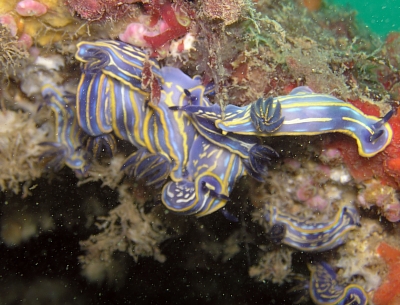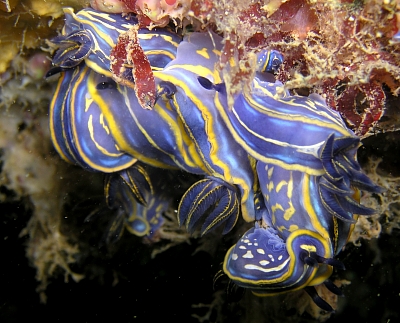Hypselodoris fontandraui - strange behaviour
June 24, 2006
From: David Abecasis

Hi Bill,
Although I've already seen some nudis together I have never seen anything like this. Probably there is more than one species present. Unfortunately the place wasn't every easily acessible so I couldn't be sure of what they were doing or of how many individuals there were. Besides the photos I'm sending I also have some more of some individuals alone.
Locality: Albufeira, 17 metres, Algarve, Portugal, Atlantic Ocean, 20 June 2006, rocky. Photographer: David Abecasis.
Best regards,
David
davidbecas@netcabo.pt



Dear David,
I think these are all Hypselodoris fontandraui. If I am right, then your photos are a very valuable example of colour variability in the species, shown perhaps most notably in the change in colour from yellow to white of the dorsal midline and its tendency to become a double line in a couple of cases.
When you see a cluster of nudibranchs together like this, you can be fairly certain that the attraction is food. It may lead to mating, because they are in close proximity, but the initial trigger for the 'togetherness' is their attraction to their food sponge. This species is reported to eat Dysidea avara [see message #5338] which is usually pink, but the greyish white sponge [see close-up] which they seem to be attracted to, looks like a Dysidea and could well be Dysidea fragilis or a colour form of D. avara.
Although this may seem 'strange behaviour', it is always a good indicator of feeding. You can always check by gently lifting an animal by its 'tail'. If it is feeding it will either be attached by its everted buccal bulb at the head end, or you will see the buccal bulb partly everted from the mouth. It is always possible that you will have more than one species together on a sponge, but in my experience, tight clusters like this are inevitably single species clusters. So this is a valuable record, because apart from confirming its food sponge, it gives us a good selection of the colour variety in the species.
Best wishes,
Bill Rudman
Related messages
-
Re: Hypselodoris fontandraui feeding
From: Marc Bosch Mateu, September 9, 2009 -
Hypselodoris fontandraui feeding
From: Antoni López-Arenas i Cama, September 4, 2009 -
Hypselodoris fontandraui mating
From: Antoni López-Arenas i Cama, September 3, 2009 -
Hypselodoris fontandraui from Portugal
From: Joao Pedro Silva, April 24, 2008 -
Hypselodoris fontandraui from sthn Portugal
From: Pedro Filipe Veiga, February 13, 2008 -
Hypselodoris fontandraui ? from mediterranean France
From: Laurent Urios, August 6, 2007 -
Re: Hypselodoris fontandraui from Cannes
From: Dominique Horst, June 26, 2006 -
Re: Hypselodoris fontandraui from Cannes
From: Dominique Horst, June 14, 2006 -
Re: Hypselodoris fontandraui from Cannes
From: Dominique Horst, June 3, 2006 -
Hypselodoris fontandraui from Cannes
From: Dominique Horst, June 2, 2006 -
Hypselodoris fontandraui from Mediterranean Spain
From: David Shepherd, October 27, 2005 -
Hypselodoris fontandraui from France
From: Marina Poddubetskaia, July 20, 2002 -
Hypselodoris fontandraui from southern Spain
From: Luis Sánchez Tocino, October 26, 2001 -
More photos of Hypselodoris fontandraui
From: Luis Sánchez Tocino, October 26, 2001 -
Hypselodoris? from southern France
From: Erwin Koehler, October 6, 2001
